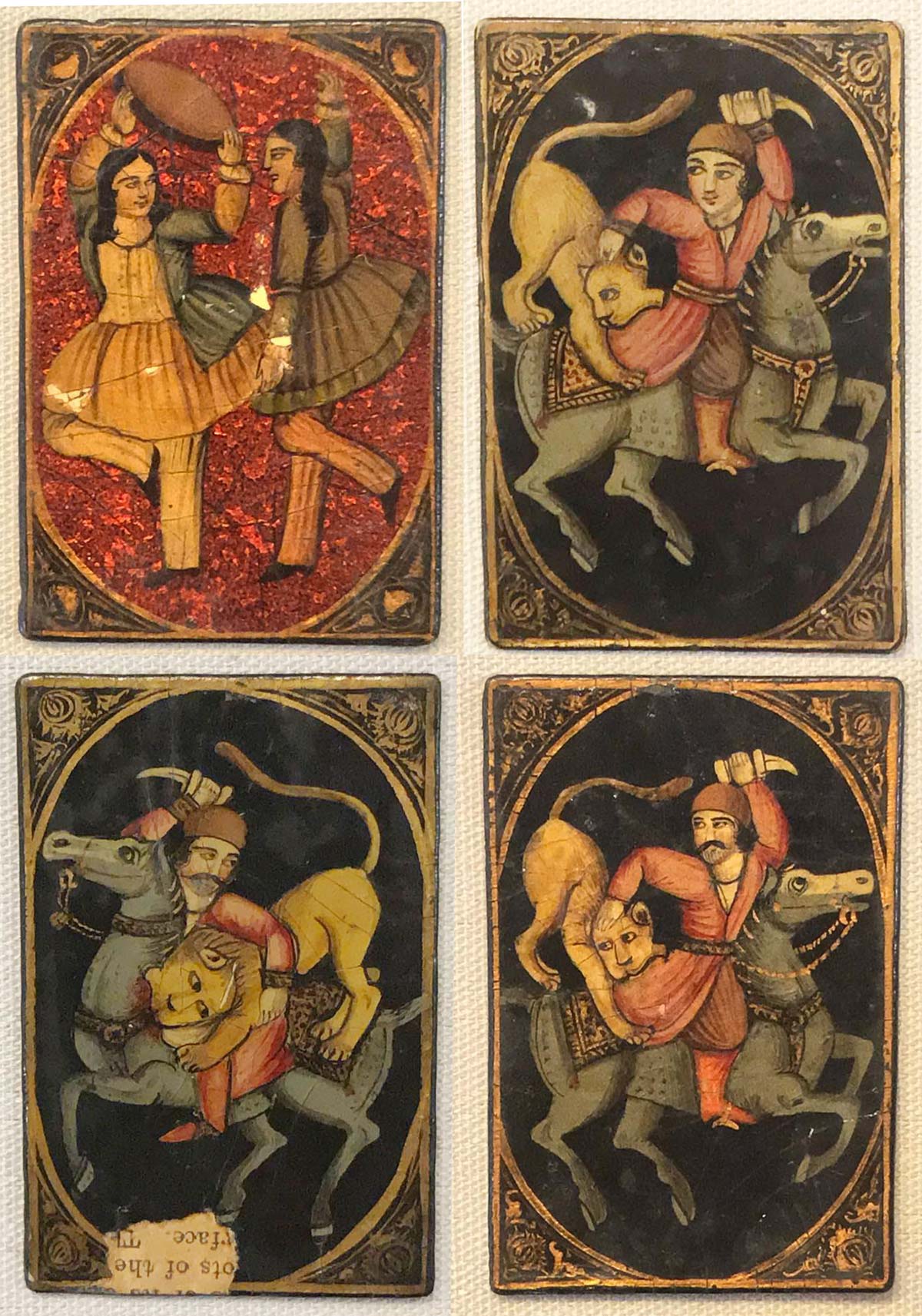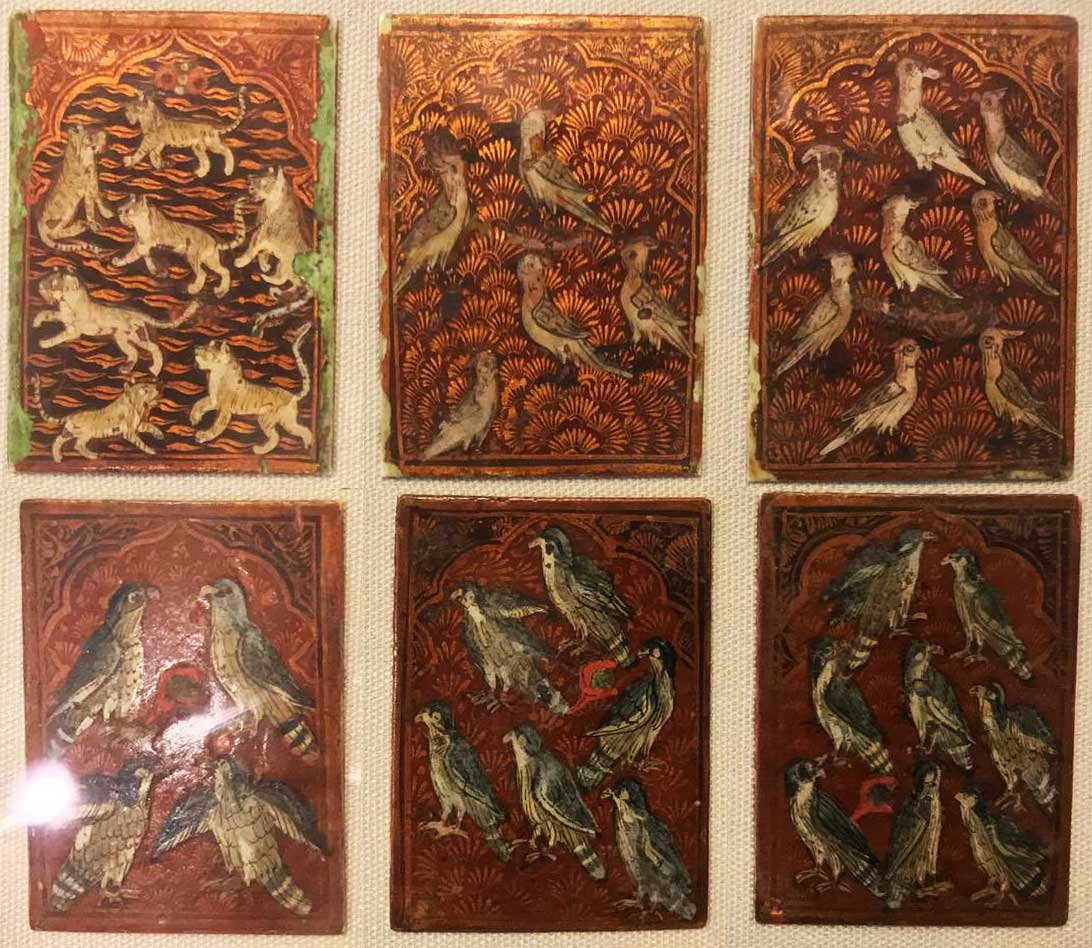Qajar Dynasty playing cards
Qajar Dynasty playing cards, Iran, 19th century.
Ganjafeh was a popular card game in Iran and the Arab world, played between two and nine players with ninety-six cards. In the Qajar period (AD.1779-1924) the poker-like game of as was played with five suits of five cards each.
Qajar Dynasty playing cards, Iran, 19th century

Above: Qajar Dynasty playing cards, Iran, 19th century, lacquer on laminated paper. Two cards come from one suit and the other two are from separate suits, but is is not clear for which game they were intended. Photograph courtesy Adam Wintle.

Above: six Qajar Dynasty playing cards, Iran, 19th century, lacquer on laminated bone. These cards include the 7 of tigers, the 5 and 8 of parakeets and the 4, 6 and 7 of eagles. Images courtesy V&A Museum, London [1914 5-18 02.1-6]. Photograph courtesy Adam Wintle.
FURTHER REFERENCES
The Rubaiyat-e-Ganjifa is contained somewhere within this larger work: Rubaiyat-e-Ganjifa►

By Simon Wintle
Member since February 01, 1996
I am the founder of The World of Playing Cards (est. 1996), a website dedicated to the history, artistry and cultural significance of playing cards and tarot. Over the years I have researched various areas of the subject, acquired and traded collections and contributed as a committee member of the IPCS and graphics editor of The Playing-Card journal. Having lived in Chile, England, Wales, and now Spain, these experiences have shaped my work and passion for playing cards. Amongst my achievements is producing a limited-edition replica of a 17th-century English pack using woodblocks and stencils—a labour of love. Today, the World of Playing Cards is a global collaborative project, with my son Adam serving as the technical driving force behind its development. His innovative efforts have helped shape the site into the thriving hub it is today. You are warmly invited to become a contributor and share your enthusiasm.
Related Articles

French Revolutionary cards by Pinaut
Seven cards from a French Revolutionary pack by Pinaut featuring characters from classical antiquity...

Rouen Pattern - Portrait Rouennais
An attractive XV century French-suited design from Rouen became the standard English & Anglo-America...

Ganjifa - Playing Cards from India
Indian playing cards, known as Ganjifa, feature intricate designs with twelve suits and are traditio...

The Henry Hart Puzzle
Explore the intricate history and unique design variations of Henry Hart's playing cards, tracing th...

Sevilla 1647 reproduction
Facsimile of Spanish-suited pack produced in Sevilla, Spain, 1647.

Why our playing-cards look the way they do
Analysis of early playing card designs: origins, suit differences, standardization, technological ad...

Introduction to Collecting Themes
Playing cards can be broadly categorised into standard and non-standard designs, with collectors app...

Le Monde Primitif Tarot
Facsimile edition produced by Morena Poltronieri & Ernesto Fazioli of Museo Internazionale dei Taroc...

75: Early American cards
An overview of some of the early cards made in the United States.

Âs Nas playing cards with box
Hand made cards from Persia

Âs Nas
Âs Nas type playing cards from Persia.

Tarot of the Thousand and One Nights (1001 Nights Tarot)
This tarot deck captures the idealised Eastern world's magic from the eighteenth and nineteenth cent...

Early German playing cards
Some early examples of popular German playing cards from the XV and XVI centuries.

The Parisian Tarot
The “Parisian Tarot”, early 1600s, with imagery and design synthesizing several influences.

73: Fakes, Forgeries and Tax Evasion
When there are official taxes to pay, people will find a way to avoid paying them - often illegally....

Russian Playing Card History - From the Beginnings to 1917
An in-depth review of the history of card-playing, gambling, legislation, manufacture and taxation o...
Most Popular
Our top articles from the past 28 days

